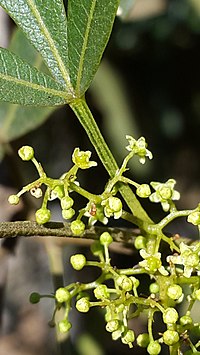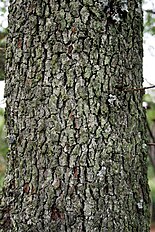bio.wikisort.org - Plant
Searsia lancea commonly known as karee (archaicly karree), is an evergreen, frost hardy, drought resistant tree, which can reach up to 8 metres in height with a 5-metre spread. In North America, where it is naturalized, it is known as African sumac and willow rhus.[2] It is one of the most common trees on the Highveld and in the Bushveld in South Africa, but not found in the Lowveld.
| Karee | |
|---|---|
 | |
| Foliage detail | |
| Scientific classification | |
| Kingdom: | Plantae |
| Clade: | Tracheophytes |
| Clade: | Angiosperms |
| Clade: | Eudicots |
| Clade: | Rosids |
| Order: | Sapindales |
| Family: | Anacardiaceae |
| Genus: | Searsia |
| Species: | S. lancea |
| Binomial name | |
| Searsia lancea | |
| Synonyms[1] | |
| |

Description and uses

The tree is dioecious.[3] It has a graceful, weeping form and dark, fissured bark that contrasts well with its long, thinnish, hairless, dark-green, trifoliate leaves with smooth margins. It bears small yellow flowers followed on female trees by bunches of small yellow-green flattish fruits, which are relished by birds. In earlier times the fruits were pounded, water added and left to ferment, producing an evidently refreshing beer. The tree is a good shade tree for gardens, parks and pavements. It favours areas rich in lime in the Karoo and Namibia.
References
- The Plant List: A Working List of All Plant Species, retrieved 28 April 2016
- USDA, NRCS (n.d.). "Rhus lancea". The PLANTS Database (plants.usda.gov). Greensboro, North Carolina: National Plant Data Team. Retrieved 21 October 2015.
- "Searsia lancea". PlantZAfrica.com. Retrieved 2021-08-26.
- Van Wyk, Braam; Van Wyk, Piet (1997). Field Guide to Trees of Southern Africa. Struik. ISBN 978-1-86825-922-9.
На других языках
- [en] Searsia lancea
[es] Rhus lancea
Rhus lancea L.f. (sin. Searsia lancea (L.f.) F.A.Barkley), comúnmente conocido como Karee.Другой контент может иметь иную лицензию. Перед использованием материалов сайта WikiSort.org внимательно изучите правила лицензирования конкретных элементов наполнения сайта.
WikiSort.org - проект по пересортировке и дополнению контента Википедии

